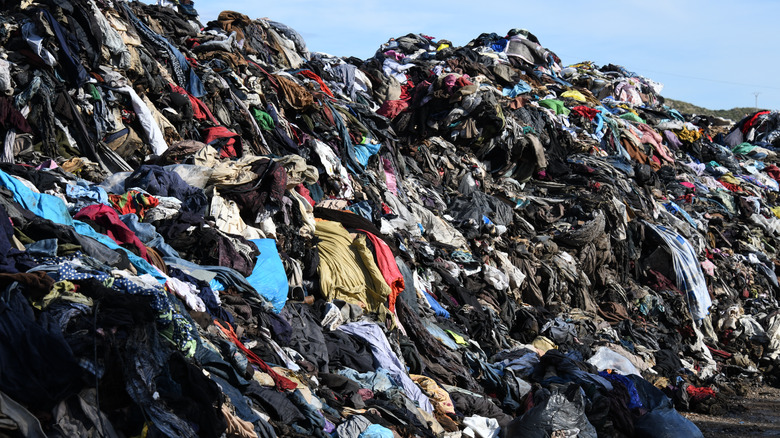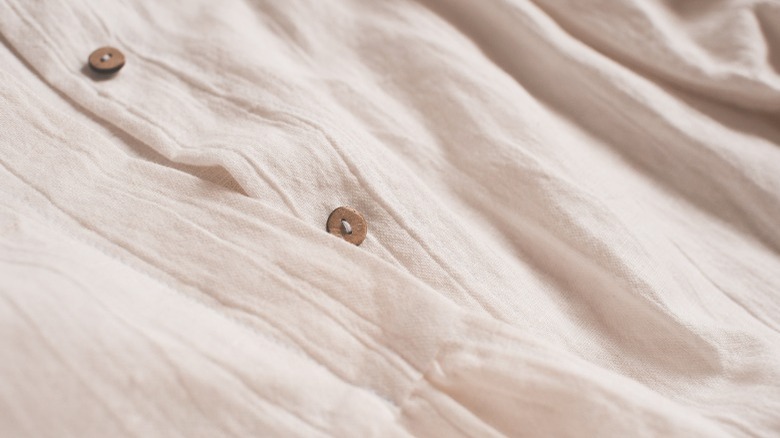Transform Your Wardrobe To Embrace The Slow Fashion Movement
With growing awareness of the impact of the fashion industry on the planet, some are looking for alternative ways of shopping in an effort to reduce their contribution to the harm it causes. The fashion industry as a whole uses a vast, even harrowing amount of resources. This includes an increasingly limited supply of fresh water, chemical pollution throughout production and manufacturing, and an overall massive carbon footprint.
We have all heard of fast fashion. This phrase is used to describe retailers that sell super cheap, mass-produced clothing items, often at the expense of an underpaid and mistreated labor force. And with the seemingly relentless appearance of micro-trends on social media — and their effect on fashion sustainability — some consumers feel the need constantly consume in order to keep up.
Now, slow fashion is meant to be the antithesis of this harmful cycle. This is more of a movement than a form of production. It prioritizes buying less and being more responsible when you do purchase items, as well as extending the lifespan of clothes already in your possession. Acknowledging the issues that overconsumption brings, slow fashion calls for more sustainable and just business models from retailers, as well as individual buying practices. Transitioning to a slow fashion wardrobe entails making small, but intentional, habitual changes over time. These include reevaluating buying habits and being selective about where your clothes come from. Here's how you can get started.
Buy secondhand fashion
Thrifting has become one of the most popular ways to buy clothes. Aside from the thrilling possibility of finding a fabulous vintage garment, thrifting ultimately lessens the demand on traditional retailers. Less clothing produced means less waste in the future.
Fast fashion is nefarious for its waste. Because of the rapid fluctuation of fashion trends, fast fashion outlets produce en masse and toss en masse. For example, popular fast fashion retailer H&M was responsible for more than $4.3 billion worth of unsold clothing in 2018, where 75% to 80% of such clothing ends up in a landfill or incinerated. The rest could be recycled or sent off to foreign countries, but this distributes the waste around the world and stifles local production of clothing in favor of cheaper options. Some countries even have bans on the import of clothing from the United States.
With so many ways to thrift clothes, including chain outlets such as Goodwill, Buffalo Exchange, and Beacon's Closet, apps such as Poshmark and Depop, and websites such as The RealReal, you can experiment with alternative ways of shopping. Some thrift stores even make an effort to curate clothing from popular retailers. You should still avoid thrifting brands of clothing from fast fashion retailers that you might not get much wear out of.
Repair and take care of clothes
Another way to practice slow fashion is to fix any clothing items that might have some wear and tear, rather than throwing them out. Have a hole in your favorite shirt? Sew it together or see a local tailor. Are the soles bent out of shape in your favorite pair of boots? Take them to a shoe repair shop. Do your best to treat stains when they happen and don't throw away an item with minimal damage that no one else would notice but you. As TikTok user @maggie_zhou relays in her TikTok video, slow fashion is all about "lending, mending, swapping, upcycling, thrifting, renting, re-wearing, remembering who made them, and just buying less."
The way you wash your clothes can also have a huge impact on their longevity. Many people have a tendency to wash their clothes too often. You can probably get away with wearing a given item several times before it needs to be freshened up. "People tend to over wash and 'over hygiene' themselves, because especially in America, we have a luxury of being able to do all that stuff all the time," says Dr. Anthony Rossi of the American Academy of Dermatology tells CNN.
When the time comes, hand wash or spot-clean your clothes where you can. This can save water when washing small items. When using a washing machine, use cold water or the lowest heat setting available, and hang up what you can instead of using a dryer. This conserves energy during the cleaning process and potentially preserves the quality of clothes over the years.
Shop with intention
When it comes to shopping, the best place to begin is none other than your own closet. When was the last time you went through your drawers and came up with new outfits based on the clothes you already have? Before you go online to buy a new garment, take stock of what you've got. Consider counting how many of which items you have in your closet, to put into perspective items you might not need more of. According to a 2016 survey by Closet Maid, women had, on average, 103 garments in their wardrobes. Over 20% of these items aren't worn and most women only actually like and wear about a tenth of their clothing items. So, instead of stocking your closet with fast-fashion pieces you won't wear in a year, focus on styling new looks with the ones you already love.
When you do feel as though you need to buy a new item of clothing, consider how you can reflect the values of slow fashion in your purchase. Is the item you want a trend piece that will quickly go out of style? Or is the item a quality piece, made to last? Clothing now is often treated as disposable. But what if you considered your clothes an investment, both for yourself and for the health of the planet?
Choose ethical brands
When it comes to slow fashion, choosing brands that are transparent about their production processes, including sourcing, materials used, and labor practices, are essential to committing to a healthier planet. Because it can be next to impossible for the average consumer to suss out which companies follow ethical practices, watchdog organizations can evaluate fashion brands and give them rankings that individuals can then access. Fashion Revolution's annual Transparency Index, which reviews publicly available brand disclosures on critical issues including human rights and environmental justice, is one of the most-trusted resources when it comes to reviewing brand ethics.
The most recent index reveals a disturbing lack of both transparency and accountability when it comes to 250 of the biggest brands in the world. For example, 50% of brands surveyed do not disclose any of their supply chain details, and 96% of brands do not disclose how many of their workers are paid a living wage. When it comes to climate change, 85% of brands reviewed do not disclose their annual production volumes, meaning they avoid accountability for the waste we can safely assume is produced.
Some of the least transparent brands, according to the index, include fast fashion outlets Shein and Fashion Nova. Some of the most transparent, non-fast-fashion brands include The North Face, Timberland, and Vans, scoring between 61% and 70% transparent. No brands reviewed were 100% transparent. Choose brands that skew toward transparency and sustainability.
Avoid harmful fabrics
Another critical aspect of the slow fashion movement is to be conscious of how the materials from which the clothes and accessories you purchase are made. It's no surprise that cheaper clothing material is made of plastics, and will never biodegrade. Even after hundreds of years, these plastic garments will simply break down into smaller and smaller parts, absorbing pollutants as they do so (not to mention, releasing pollutants as plastics are made). Slow fashion asks us to consider buying clothes made of natural fabrics, clothing that will eventually biodegrade, and, as a bonus, is not made of pollutants.
Some of the most popular materials used for making clothes are synthetic and semi-synthetic fibers, which are typically made from mostly plastic. Sustainable Jungle cites a list of synthetic plastic fabrics, including acrylic, nylon, polyester, polypropylene (used in underwear and activewear), spandex, and vinyl. Semi-synthetic fabrics include rayon, viscose, and some bamboo fabric, which go through extensive chemical processing.
Synthetics and semi-synthetics are popular with manufacturers and consumers alike because they are durable, inexpensive, and often waterproof. But natural fibers, including organic cotton, linen, wool, hemp, and silk, are better for your skin and the planet, as well as being long-lasting and beautiful. Although more slightly more expensive and care-intensive, these clothes are far less harmful. Slow fashion starts with making more intentional choices when building your wardrobe.





